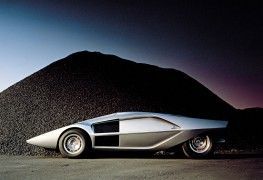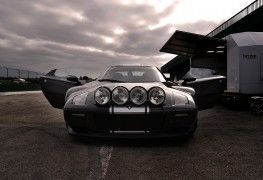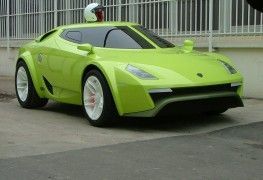As life would have it, Giugiaro left Bertone two years later, and Bertone didn't hesitate to hire Gandini for its design team. Marcelo's evolution at Bertone was noticeable, even though he was just "one more". His first great known work would be the Miura. In 1966, Gandini created the bodywork design for Lamborghini's first transverse-central V12. From there he would evolve his curvilinear aesthetic concept towards much straighter, wedge-shaped, futuristic, risky lines, and markers of the essence of Gandini's design. The first example of this new line of work was the Alfa Romeo Carabo.
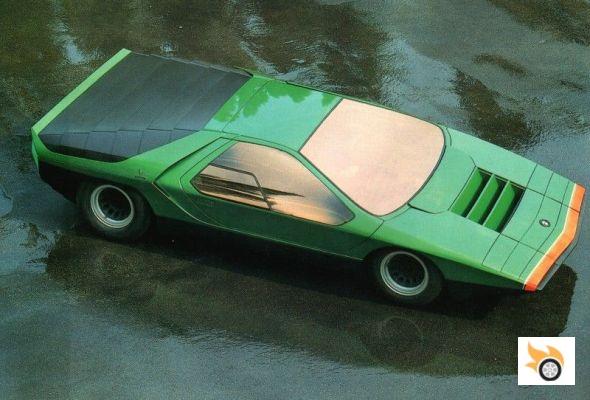
The Carabo is the direct "father" of the Stratos Zero.
The Carabo was a prototype mounted on the chassis of the famous Alfa Romeo 33 (the mid-engined GT sports car, not the 1980s utility car). Among its aesthetic cues we could see for the first time the guillotine doors that would see production on Lamborghini's Countach years later. Its heart was the same V8 as the race car, but it adorned it with a modernist aesthetic, risky, sharp, coined, like something out of a science fiction movie.
People may not remember the Carabo very much, but with it Gandini had created a model that would inspire a whole generation of sports cars, not of one brand, but of the entire automobile industry.
The Carabo was no more than a showroom prototype, but the idea of its design did not remain "water under the bridge". Gandini's intrepid imagination was still "hyperactive", and based on the same design he created the Lancia Stratos Zero in 1970.
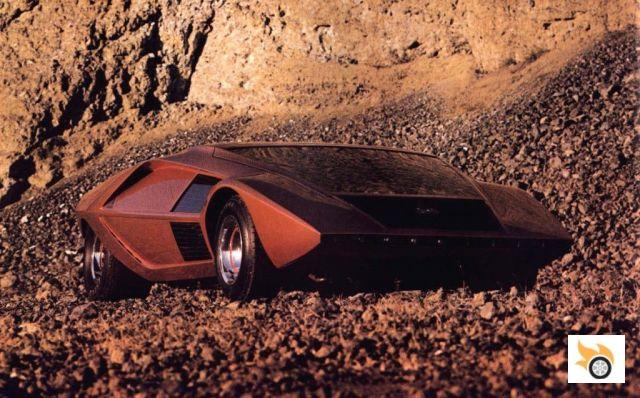
The Stratos Zero in its characteristic orange
The project was born as "Progetto Zero" in Gandini's hands, commissioned by Nuncio Bertone, with the idea of convincing Lancia that the best thing to do was to create a new concept car with which to relaunch the brand, just after its entry into the Fiat group. The project was created behind the brand's back. Gandini was in charge of both the aesthetics and the engineering and packaging development of the car.
He imagined a mid-engine car with four cylinders in V and 1.6 liters, with very curious proportions: very low, very wide and very short. Nuncio Bertone took the car to the Turin Motor Show as the jewel of his coachbuilding company.
The car's bodywork was designed to reduce the aerodynamic drag coefficient as much as possible. Driver and passenger entered through a tilting windscreen that had the same inclination as the nose of the car. The Lancia engine was placed just in front of the rear wheels, in longitudinal position, and between it and the passengers there was space for the radiators, the air intakes and the spare wheel.
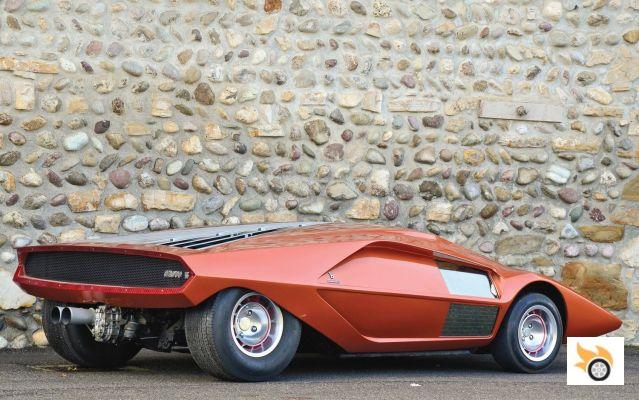
As a skeleton it had a central monocoque in stamped sheet metal to which were joined two tubular subframes in which were articulated completely independent suspensions for each axle. The bodywork was made of fibreglass to keep the kilos in the balance.
And then Cesare Fiorio came on the scene, and when he stood in front of the Bertone stand he had "a vision". Fiorio had managed to build an excellent reputation, despite being a young man of only 31 years old, he had been managing the Lancia rally team, called HF Squadra Corse, since 1963, with outstanding successes first with the Flavia and then with the Fulvia.
With the Alpine Renaults and Porsche's pushing hard in world rallying, Fiorio had been thinking for some time about a solution to replace his increasingly uncompetitive front-wheel drive Fulvia.
When he set his sights on the Stratos, Cesare quickly dreamt of transforming Gandini's daring concept into a production model, of which he could build 500 units to be homologated as a Group 4 with the Lancia logo, and make it the ultimate rallying weapon. Being able to create from scratch a mid-engined car designed by and for racing had its huge competitive advantages, and with the backing of the giant Fiat, money needn't be an issue, even if the cars didn't sell. It was an approach that no one had ever taken before, although years later we would see something very similar with the Group Bs.
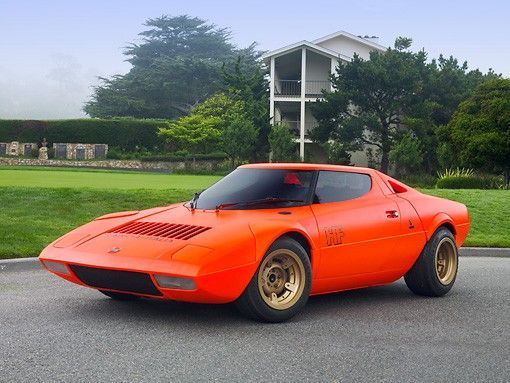
The Lancia Stratos HF Prototype was the first step towards the production version.
Nuncio Bertone wanted to get the project to Fiat by any means possible, but the managers of the Italian brand didn't want to know anything about it. Bertone, confident that he could convince them in a face to face meeting, stood at the door of the Fiat facilities in Turin, but the head of security of the company received orders not to open the barrier, because they did not want to receive him inside. That was not enough for Nuncio, who dared to go under the barrier, taking advantage of the reduced height of the Stratos. After much to-ing and fro-ing, Nuncio's determination, Fiorio's desire, and Lancia's very bad situation resulted in the OK for the project, which also had hidden interests. Ferrari had decided to kill the Dino 206 with a six-cylinder engine, and there was going to be a large stock of engines available, so they could be reused. This part of the story may sound like a myth, but that's how its protagonists tell it, and this car is full of events and coincidences without which we wouldn't have known the best rally car in history.
The name Stratos is another myth. Some say that it was chosen after looking at a box of a model of an airplane that was swarming around the Bertone facilities, and that according to the people in charge of making the prototype, it was very similar in its aesthetics. Since the name of the plane was "Stratos", they decided to name the new Lancia the same way. Others say that an employee in charge of making the prototype, referring to the extravagance of the design, called it Stratos because it was a design from "outside the stratosphere".
With the contract on the table, Bertone won a deal to build 500 Stratos, which would have to evolve on Gandini's original design.
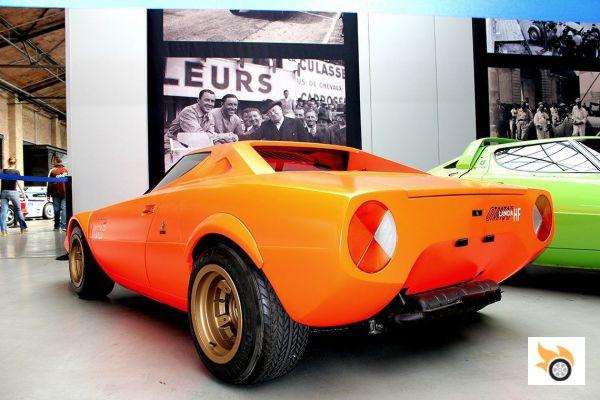
Orange characteristic of the HF Original Prototype
Unlike many other designers, Gandini was also a friend of engineering, so he joined forces with Cesare Fiorio and Gianpaolo Dallara (yes, the one from Dallara, the racing cars) to delineate what the production car would look like. In a year of work, the Stratos Zero was transformed into the Stratos HF prototype, with aluminium bodywork and a phosphorescent orange colour. The British driver Mike Parkes would be in charge of collaborating in the tuning of the car.
The car already had a Ferrari transverse V6 heart with a cast iron block, and a ZF gearbox with first gear to the left and backwards. Gandini was still interested in mounting the Lancia V4 prepared by Abarth, with less weight and in longitudinal position, but Fiorio and Fiat pushed to integrate the six-cylinder of the Cavallino, with more power and greater possibilities of preparation, but also heavier and more complicated to put in the "hole".
During the development of the car, Fiorio's clear ideas were those of a racing car, and Gandini applied his magic to pursue the objective of having the function mark the form. Thus, the final car had one-piece front and rear bonnets, completely removable to facilitate service on the car in the service parks. The suspension was fully adjustable and adaptable, so that it could be used on asphalt, dirt or snow without wasting too much time changing settings. The safety arch itself was a structural part of the car and the doors had integrated spaces for the helmets of the driver and co-driver.
The format of the panoramic windscreen was designed to offer the best possible forward visibility to the driver, in order to make it easier to position the car in the narrow sections of the rallies.
The Stratos HF prototype was presented at the 1971 Turin Motor Show, but it was incomplete and non-functional. It would take until the 1972 Turin Motor Show to see it in a conceptual form but already 100% functional.
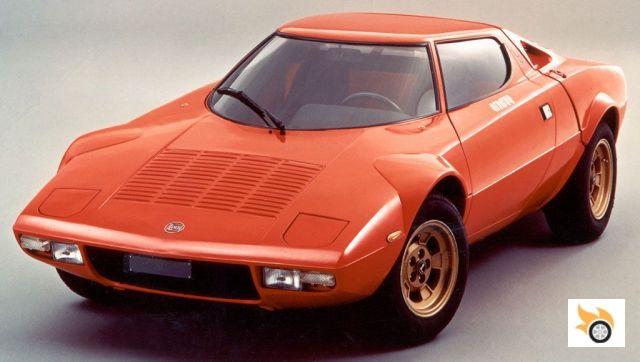
The production version changed little compared to the HF Prototype.
From then on, the car's fine tuning began, and the production of the first 50 pre-series units, which still counted towards the total of 500 required for its homologation as a group 4, began.
After continuous refinements thanks to racing tests, the Stratos improved and production began timidly in 1973 before going "full capacity" in mid-1974. From then until the end of production, between 492 and 502 units would be built (the first figure quoted by experts in the field, the second, the "official" Bertone figure). By the time Lancia homologated the car in Gurpo 4, the production requirements had dropped to 400 completed units.
The bodies were made by Bertone in Grugliasco, and then sent to Lancia's Turin facility for assembly. The car had a steel monocoque with additional structures at both ends in tubular form to support the suspension. The body was made of fiberglass. The Ferrari 2.4-litre V6 engine was in a central rear transverse position, mated to a five-speed gearbox. It offered 190 horsepower in its street specification, and was capable of powering this little Italian (3,708×1,750×1,110 millimeters long by width by height) of only 980 kilograms.
With these specifications the car achieved a 0 to 100 km/h in less than 5 seconds with a top speed of 233 km/h.
And the sporting successes began to come
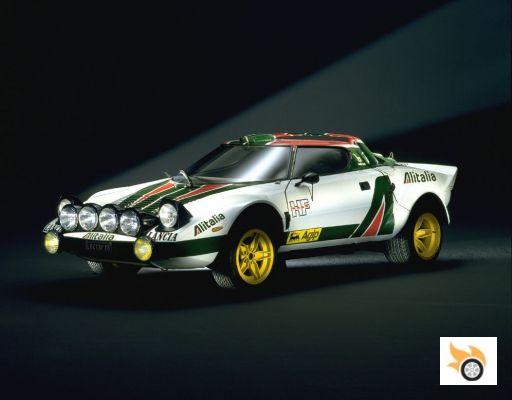
The racing version would become a legend.
The Stratos' sporting history began before it received Group 4 homologation, and even before it was in production. In 1972 it would take part in its first race in the hands of Sandro Munari, in the Tour de Corse no less, where the brilliant Italian driver would abandon in the second unit built of the car, due to a suspension problem.
A month later, the failure would be repeated in the Spanish Rally Costa del Sol. Like any good racing car, reliability in competition had its effect, and running as a Group 5 prototype helped to detect these problems before the car was already in production, so the development team had the opportunity to refine the design and cure all the problems of youth.
In 1973 the Stratos made another appearance in Spain, this time to win the Firestone Rally, while a month later it achieved an excellent second place in the Targa Florio. The Tour de France of September '73 was also won with solvency by Munari, who was beginning to know how to get the quintessence of the complicated but effective Italian car.
In 74 the car would get its Group 4 homologation, and with it, Lancia would win the Constructors' Championship titles in 74, 75 and 1976. In the latter year the Stratos dominated at will, achieving numerous double wins, hat-tricks, and the fourth consecutive victory in the Montecarlo.
In 1977 Fiat would decide to end the Stratos' career to benefit and give the option to win to its Fiat 131 Abarth, an option that commercially was more interesting, as it would help to sell the new Italian sedan. But the Stratos would remain active until its homologation expired in 1982, still achieving important victories, such as the 1979 Monte or the 81.
After the end of its homologation, speculation and the low number of units produced have helped to keep it as a living legend, which can now participate in classic events, where new generations of rally fans continue to be attracted by its enormous appeal.
After all, it has often been recognised as the most beautiful rally car of all time. It laid the foundations for an entire generation of design in the 1970s, with the "arrow" shape, while at the same time laying the foundations for the idea of the Group B rally car.
From the Lancia Stratos to the New Stratos: The story of the dream machine